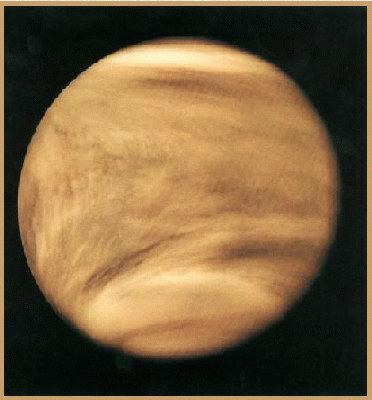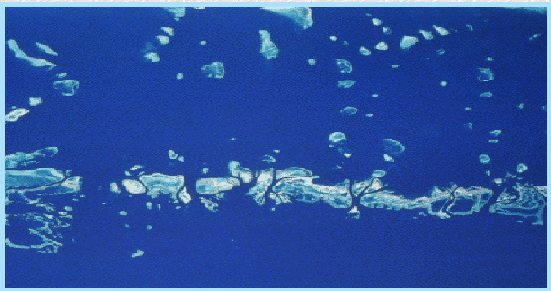 Lesson 2:
Lesson 2:
 Earth
Earth
 Planet of Life
Planet of Life
|
 2.4
2.4
 Carbon and Oxygen
Carbon and Oxygen

|
 |
Figure 2.4.1
 The Clouds of Venus
The Clouds of Venus
|
Of our planetary neighbors in space, Venus most closely resembles Earth in
size and mass: it is only slightly smaller than our home planet. One would
expect, therefore, that the internal structure of Venus is similar to that
of Earth. The fact that Venus has a dense atmosphere shows that gravitational
segregation has taken place and that considerable amounts of water must have
been delivered to the surface of the planet. The question of whether much,
little, or no water exists near the surface of Venus has only been settled
very recently, mainly by direct probing. The reason is that the clouds of
Venus, which give it the wonderful brilliance of the "morning star" (or
"evening star"), obstruct observation of the surface. The space probes
showed that the surface temperature of Venus is very high, almost 500
degrees Celsius. Iron glows dark red at this temperature. Water, of
course, evaporates under such conditions. Thus, we would not expect an
ocean, but a water vapor atmosphere.
The shocker is that the heavy atmosphere of Venus (nearly 100 times
the pressure of Earth's) is dry and consists almost entirely of
carbon dioxide -- a gas which makes up only 0.03% of Earth's atmosphere!
The clouds are made of sulfuric acid. Not a nice place.
 |
 |
Figure 2.4.2
 Radar image of the surface of Venus
Radar image of the surface of Venus
|
In the atmospheres of both of Earth's sibling planets carbon dioxide is by far the dominant gas. On both planets, there is more CO2 in the air than on Earth. On Venus it
is about 300,000 times more! On Mars, the atmosphere there has a pressure only one hundredth or so of that on Earth, but 95 percent of it is carbon dioxide. So, even on
this small planet, with its thin atmosphere, there is much more carbon in the air than on Earth. Our home planet does have enormous amounts of carbon dioxide on its
surface. The ocean holds about 60 times more carbon dioxide than the atmosphere. But the bulk of the carbon dioxide on the surface of Earth is elsewhere. Practically all
of it is tied up in carbonate sediments and in coal and other organic matter. Shell-making organisms and plants and algae ultimately are responsible for this large-scale
solidification of carbon dioxide within carbonates (limestone rocks) and also within organic materials.
 |

|
Figure 2.4.3
 The Great Barrier Reef
The Great Barrier Reef
A coral reef composed limestone produced by algae.
|
Making coal and other organic matter also led to splitting the carbon from
the oxygen, with much of the oxygen staying in the air. This produced an
atmosphere fundamentally different from those of Venus and Mars - one that
is greatly impoverished in carbon and greatly enriched in oxygen. If left
alone, the oxygen would readily re-combine with the organic carbon in the
near-surface sediments on Earth.
The atmosphere is chemically out of balance
and therefore "unsustainable" except by ongoing life processes.
When looking at the system in this way, we see that the low carbon dioxide
values are a result of moving CO2 from the reactive reservoirs
atmosphere-plus-ocean to the much less reactive reservoirs (limestone-
plus-organic matter). When limestone rocks are heated (in mountain-making
processes), the carbon dioxide is released back to the atmosphere, as
volcanic emissions. Weathering and life processes then have to move carbon
dioxide back into the long-term storage, to keep the atmosphere from filling
up with the gas. This cycle runs on a time-scale of millions of years.
Mainly, it involves reacting silicate minerals exposed near the surface of
the Earth with carbonic acid (from the reaction of dissolved carbon dioxide
with water) and precipitating the resulting dissolved ions as calcium
carbonate (calcareous sediments, limestone rock) and siliceous deposits
(diatomites, chert) in the sea.After being buried and sitting around
long enough, calcareous sediments and opaline sediments become solidified
into limestone rocks and chert, respectively. (Chert is also called "flintstone".)
The precipitation of the carbonate is by organisms (algae, corals, mollusks,
foraminiferans) and the precipitation of the silica is by diatoms,
radiolarians and sponges. Thus, the content of carbon dioxide in
the atmosphere is largely tied to life processes, as is that of oxygen.
By moving carbon dioxide out of the atmosphere and into solids, Life
has changed the heat balance of the planet, making it cooler than it would be otherwise.
(We are now reversing this process to some degree by burning coal and oil.)
Oxygen is freed when carbon is tied up in coal and other organic matter. It has, in fact,
another important source, that is, water. It is freed from water (oxygen-hydride)
when ultraviolet light splits off the hydrogen. Hydrogen is the lightest gas, and
its molecules tend to leave the planet more readily than any other. What remains is the
oxygen. On Mars, leftover oxygen combined with the iron in basaltic rocks to make
rust, which gives the planet a reddish appearance.
 |

|
Figure 2.4.4
 Mars
Mars  The Red Planet
The Red Planet
|
On Earth, gravity is strong enough to greatly slow the escape of hydrogen,
and carbon dioxide therefore is the more important source of oxygen.
Oxygen does not build up indefinitely, but tends to stabilize at present
concentrations. One reason is that there are plenty of sinks for oxygen,
in the re-oxidation of organic carbon, and in the oxidation of basaltic
rock (which contains reduced iron eager to combine with oxygen) and of
sulfides. The more oxygen, the more readily these reactions proceed,
diminishing the oxygen. (This is called "negative feedback".) Also,
at some point, if the oxygen rises much higher than present values,
forest fires and all kinds of spontaneous combustion would increase
in frequency and severity.
The fact that carbon and oxygen partake in the same kinds of processes
links their cycles very closely. In addition, since both these cycles
depend on life processes, they are also closely linked to the cycles
of those elements that play an important role in living organisms.
These are mainly the nutrient elements phosphorus and nitrogen, but
also certain metals such as iron, calcium, barium, molybdenum and copper,
to name but a few. Each of these elements has a cycle that is at least
partly controlled by life processes.
The single most important process linking carbon and oxygen is
photosynthesis:
CO2 + H2O + nutrients + energy -->
CH2O (nutrients) + O2
Carbon dioxide + water + nutrients + sunlight -->
 organic matter +
free oxygen organic matter +
free oxygen
Read backwards, the equation describes bacterial decay, in which
organic matter is burned, using oxygen.
|





















